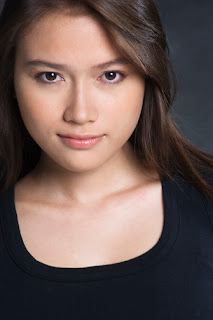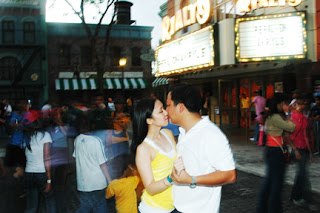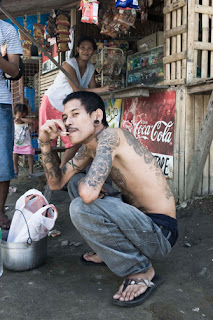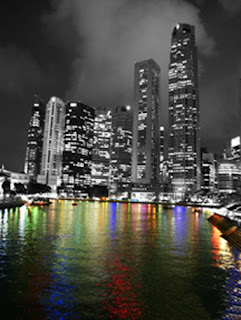Day 1
So you want to be a photographer?
There are different levels of photography, on the leisure class there would be the clicker who would shoot occasionally or when he wants to. There are the serious hobbyists who would go around spending for gadgets and travel just to satisfy their need to capture images. There are the intellectual photographers who are the knowledge eaters, they read and read and read but do not shoot, ask them anything and you get an instant answer. There are the professional photographers who earn their living getting paid to take pictures. They can be wedding photographers, photojournalists or commercial photographers. And there is the artist photographer who just shoots what he likes to shoot for the sake of art. Any of these I mentioned can be you so before even thinking of advancing your way to being called a PHOTOGRAPHER you first need to know the kind of photography you want to do.
In order to know what you want you need to determine your goal, ask yourself “why do I want to learn”? maybe because you want to be a professional photographer or just make it a hobby or just to know. After answering the question ask yourself “What is my interest or what it is that interests me?” is it shooting landscapes? People? Candid moments? Sports? Cars? To know the branch of photography you are interested in it is best to check out newspapers, books and magazines to know the kind of photography that strikes you. A portrait maybe or an advertisement or documentary photo. Only by knowing these things will make you appreciate photography because you know what you want and if you get what you want, then you know you have a new knowledge.
Assignment A:
1. Write down the reasons why you want to learn photography, where are you going to use your knowledge? What kind photographer you want to be, a professional if yes what kind of practice, if no, what is the extent of your hobby? The answers here are important it will tell if you want to be a professional or just a hobbyist
2. get a photo you personally took and write down the reasons why you like it. Take hold of it because you will compare it to you pictures after finishing all the assignments.
3. Get a photo you did not take, something that caught your attention, it maybe from a magazine, newspaper or Internet, anywhere as long as you did not take it and then write down the reasons why you like it. The reason will determine the style you want for your shooting
Practical photography
This is a lesson that will help readers jump-start their way into taking pictures. I made everything easy to read and understand, no camera jargons or technical hullabaloos. I didn’t put a lot of information because I want readers have the freedom of trying and experimenting, by doing so students and readersbecome more creative in their approach to photography.
The main goal of this reading is to elevate the skill of a photographer with the introduction of technical terms and technical skills in photography. And at the same time developing the creativity of the photographer by doing exercises suggested in this manual
These are just the basics and the important foundations for an inspiring photographer. Much of the photographer’s knowledge is gained through shooting and experience. I learned mine through shooting, and shooting a lot of films. To those who want to learn photography it doesn’t just take a click of the camera’s shutter to capture a subject. A subject needs to be treated with a lot of thought and careful study on how to make it appealing as a photograph. Remember that a photograph is never accompanied by words so the message of the photograph has to be clear, if the message is happy baby just make sure that the body language of the baby is happy by showing a smile or laughter.
Learn and enjoy through this simple practical photography guidelines.
Basic Vocabulary:
Camera is a tool used to capture an image to make a photograph.
Lens is a part of the camera where light passes through.
Photograph is an image captured on Film or imaging sensor
Film is where the image is recorded.
Imaging sensor is the “film” of the digital camera.
Film Sensitivity is the measure of film’s sensitivity to light. It is measure in ISO 100, 200, 400, 800 and 1600. Lower the number requires longer exposure, the higher the number the more sensitive to light thus requiring less light to capture the image. Practically, if you don’t have a tripod use a higher sensitivity on low light situation because this will not require longer exposure but quality may suffer because of noise or grain on the photo.
(A noise or grain is like little dust particle on the all over photo.)
Sample of a grainy or noisy photo, the picture looks rough.

Aperture* is the hole or iris in the lens where light passes through. This means that the bigger the hole the more light is allowed to reach the film or digital sensor (for digital camera). The symbol is f, and the following are the openings f/16, f/11, f/8, f/5.6, f/4, f/2.8, f/2, f/1.4. to open up one stop means turning the aperture from f/16 to f/11 (if your setting is on f/16), to open up two stop (if the setting is on f/16) means turning the setting from f/16 to f/8. Remember that the lower the number the bigger the opening of the aperture therefore allowing more light to pass through the hole and the higher the number the less light that comes in
Shutter speed* is the time for which the shutter curtain is held open during the taking of an image to allow light to reach the film or imaging sensor. The longer the shutter is open the more light captured on film. Common shutter speeds are from fast to slow: 1/2000, 1/1000, 1/500, 1/250, 1/125, 1/60, 1/30, 1/15, 1/8, 1/4, 1/2 of a second and 1 second. The symbol B on the shutter speed dial means manually leaving the shutter open until the photographer closes it. Leaving the shutter on setting like 1/2 of a second means more light is recorded on film.
*Check your camera manual on how to or where to adjust
Things to know about your camera Digital or Film
Exposure modes:
1. Manual. This setting will allow you to manipulate the shutter speed and aperture setting giving you more creativity to your image
2. Aperture Priority. This setting allows you to manipulate on the aperture setting making your shutter speed to automatically set its own exposure. You normally use this when you want a shallow or great depth of field (Depth of field or DOF is explained on later lessons)
3. Shutter Priority. This allows you to assign a shutter of your choice and the aperture automatically sets itself as you shoot. You normally use this if you want to have an effect of blurring or freezing motion which I shall explain on later lessons
4. Program mode. This mode allows you to just point and shoot. The camera take care of everything.
ISO setting
This is considered to be the film speed (check on film speed/film sensitivity)
Picture Quality
This is the file size of the photo you are to capture
White Balance
There are several settings for the white balance such as daylight balance, tungsten, auto, custom (custom balance allows you to manually set your color white by taking a photograph of any white surface you point the camera to.) Set the white balance in accordance to your lighting condition to make sure that white appears as white and does not cast any color on the photo.
Different types of metering modes
1.Matrix metering or evaluative (name depends on the manufacturer.) This meter mode will get the average light of the whole frame.
2. Center weighted metering. This meters the subject closer to the center of the frame.
3. Spot metering. Meters a very specific spot and you need to override the meter reading if the surface is not middle grey
Photography means painting with light. Now, in order for you to produce a photograph you need light, light to bounce off from an image, pass through the lens and that light that bounced off from the image is also the light that is captured on the film or a digital sensor.
Exposure means to expose the film on light to allow the capture of image. Expose it more than the recommended setting then the picture gets over exposed, as a result the image is too bright. Expose the film under the recommended setting means the pictures get under exposed or the picture gets dim. Question! How do you know the proper exposure? ( Notice I used proper exposure and not correct exposure because there is no correct exposure in photography. Some photos are nicer when it is a bit dark or a bit bright. The final call is with the photographer. The light meter is just a guideline to ensure the photo taken is neither too dark nor too light.) Most cameras today comes with built in exposure meters, if it doesn’t then you need a light meter or spot meter to check the right amount of exposure. Next question! How do you read exposure? First and foremost you have to understand how a camera meters work. Camera meters are stupid they don’t see colors only the reflection of light; they only see dark, middle grey, and bright light. Remember this, Black does absorb light so if you point a meter or the camera on a dark surface the meter thinks that the camera needs to expose the film longer therefore if you shoot using the setting given by the meter the result would be an overexposed picture, so you have to override the meter by closing 1 or 2 stops either the aperture or shutter speed. On the other hand, if you meter a white surface or bright surface the meter will think that it is capturing a very bright surface because white bounces off light so if you use the setting recommended by the light meter the result will be an underexposed photo so again, override your meter by opening 1 or 2 stops, either the aperture or shutter speed. Metering a middle grey surface will be the right way to do it. Its either you buy a middle grey card or if you don’t get one, meter a white surface and just adjust the aperture or shutter by 1 stop to 2 stops over exposed. If there is no white surface try it on dark surface just open up by 1 or 2 stops.
Nowadays everything is easier because of the digital camera but what if there is a need to use a film camera. It is still best to know the basics of photography rather than relying on technology.
Taking a picture
In order to capture an image you need to remember a few things before clicking the shutter.
1. Be sure to set the proper exposure or to put it in any exposure mode (manual, shutter priority, aperture priority or program) you desire
2. Hold the camera properly to secure from any camera shake
3. Focus on the subject. (If you are taking a picture of a human subject be sure to focus on the eye) Make sure that focus is correct to make the subject sharp.
4. Compose the Picture using some rules in composition (rules will be discussed in the following lessons).
































